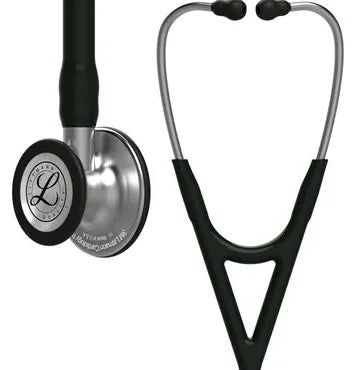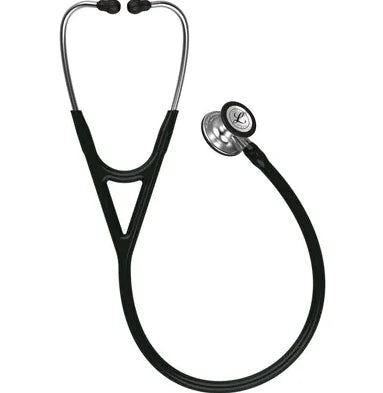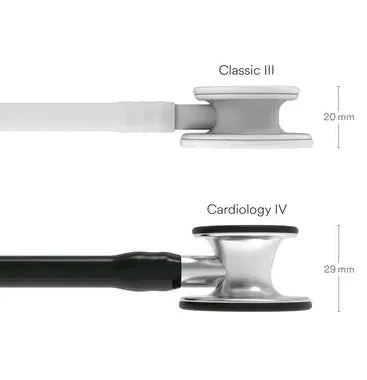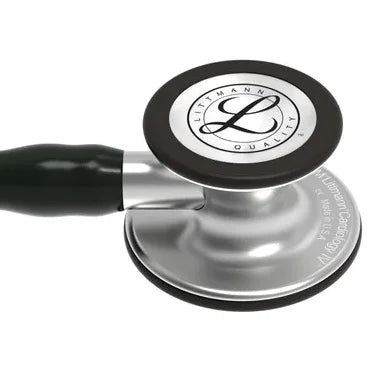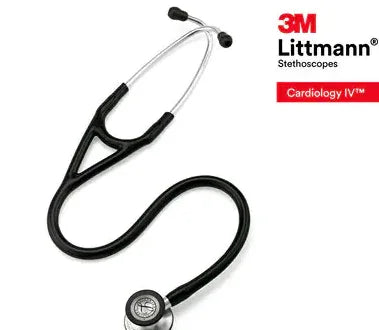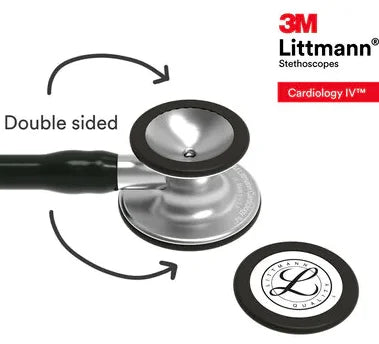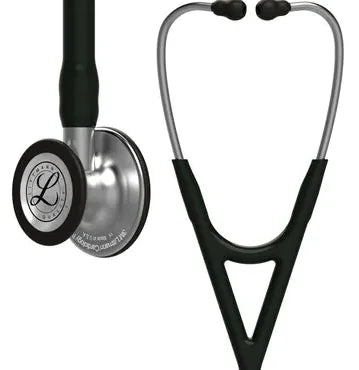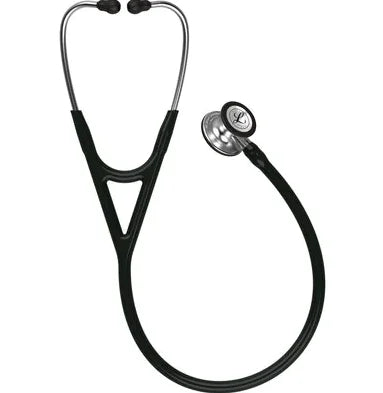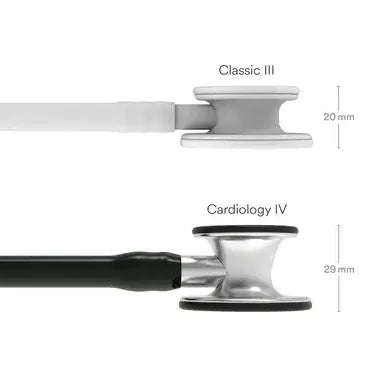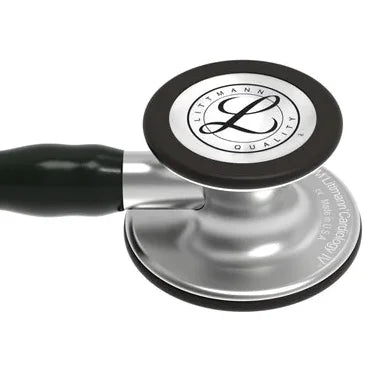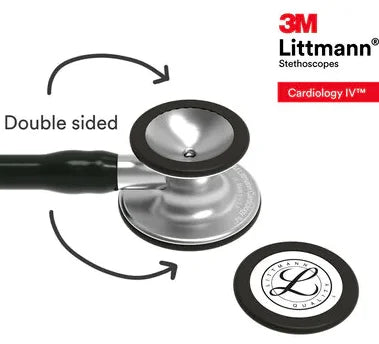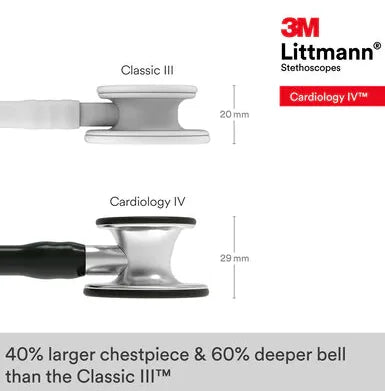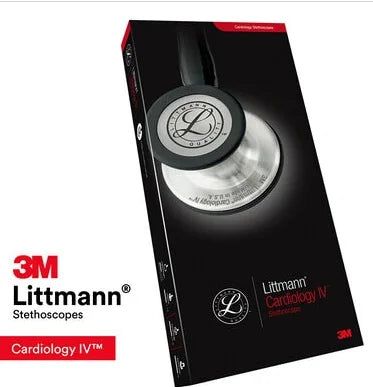Medworld Trade
3M Littmann Cardiology IV Diagnostic Stethoscope, 6152, Standard-Finish Chestpiece, Black Tube
3M Littmann Cardiology IV Diagnostic Stethoscope, 6152, Standard-Finish Chestpiece, Black Tube
Couldn't load pickup availability
3M Littmann Cardiology IV Diagnostic Stethoscope:
- Excellent acoustics that can hear high-frequency sounds clearly (adult side)
- Tunable dial: You can hear high- or low-frequency sounds simply by adjusting the pressure on your chest.
- Dual-lumen tubing - Two sound paths in one tube reduce rubbing noises from double tubes
Details
- Excellent acoustics that can hear high-frequency sounds clearly (adult side)
- Tunable dial: You can hear high- or low-frequency sounds simply by adjusting the pressure on your chest.
- Dual-lumen tubing - Two sound paths in one tube reduce rubbing noises from double tubes
- Next-generation tubing is more durable and resistant to stains. It is not made with natural rubber latex and phthalate plasticizers.
- A headset allows for personal fit and comfort. The ear canals are aligned with the angled ear tubes.
- A seven-year warranty gives you greater security.
The Littmann(r), Cardiology IV(tm), Stethoscope is designed for clinicians who require exceptional acoustic performance and extraordinary versatility. The innovative design features a single-piece, tunable diaphragm that can be attached to each chest piece.
The 3M(tm), Littmann(r), Cardiology IV(tm), and Stethoscope are the next generation in a well-respected stethoscope. It offers improved acoustic performance and better audibility for high-frequency sounds (adult side; firm pressure). The distinctive, chalice-shaped chest piece features tunable diaphragms at both ends, providing outstanding acoustic performance and diagnostic versatility. It is also convenient for treating pediatric and adult patients. You can convert the pediatric side of this chest piece to an open bell by removing the tunable dial and replacing it with the non-chill bell sleeves.
Both the adult and pediatric sides have single-piece diaphragms. They are simple to attach, remove, and clean.
Tunable diaphragm technology, a 3M invention, allows clinicians to hear different frequencies by simply changing the pressure on their chest pieces. To hear low-frequency sounds, press lightly on the chest piece. Press a little harder to hear higher frequencies. It saves time and allows the clinician to concentrate on the patient. The patient is comfortable with the non-chill edge.
Adjust the headset tension by pulling or pulling on the ear tubes. Ear tips are softly sealed and fit the individual's ears for a perfect acoustic seal. Ensure safety. Ear tips are held securely onto the ear tubes. It is difficult to remove them.
Dual-lumen tubing is a combination of two sound paths within one tube. It eliminates the rubbing noise that double tubes can make. It allows clinicians to hear patient sounds without as much interference.
Next-generation resilient tubing is flexible and retains its form even when folded tightly into a pocket. Because it is more resistant to alcohol and skin oils, it will last longer and be less likely to catch stains. The next-generation tubing is not made with natural rubber latex. It is an excellent benefit for sensitive clinicians and patients. The next-generation tubing does not contain phthalate plasticizers to protect the environment and human health.
The Cardiology IV Stethoscope is not just for cardiologists. Specialists use it, and general practitioners, physicians, EMTs, critical care nurses, medical students, and other healthcare professionals listen to and study cardiac, and lung activity sounds in adults and children. The Cardiology IV stethoscope is made in the USA. It comes with a seven-year warranty. The Stethoscope has both large and small soft-sealing tips and health tips. It also comes with instructions and non-chill bell sleeves.
Millions of doctors worldwide use 3M(tm), Littmann(r) stethoscopes to ensure the best possible patient outcomes. Littmann stethoscopes are renowned for their outstanding acoustic performance and high quality. A Littmann Stethoscope symbolizes your dedication to medicine and personal success.
Specifications:
|
Application
|
Cardiology/High Performance
|
|
Approved Environmental Marketing Claim (EMC)
|
3M™ Littmann® tubing does not contain phthalate plasticizers. It improves resistance to skin oils and alcohol, and is less likely to pick up stains.
|
|
Binaural Construction
|
Double Lumen
|
|
Brand
|
Littmann®
|
|
Chestpiece Finish
|
Machined Stainless Steel
|
|
Chestpiece Technology
|
Double-sided
|
|
Chestpiece Weight
|
3.1 Ounce
|
|
Chestpiece Weight (Metric)
|
87 g
|
|
Diaphragm Diameter (Metric)
|
4.3 cm
|
|
Diaphragm Material
|
Epoxy/Fiberglass
|
|
Diaphragm Type
|
Tunable, single-piece
|
|
Eartip Type
|
Soft Sealing
|
|
Environmental claim being made
|
Yes
|
|
Environmental claim relates to
|
Product
|
|
Evidence for Claim
|
Self Certified
|
|
Extra Eartips
|
Yes
|
|
Headset Material
|
Anodized Aluminum
|
|
Model
|
Cardiology IV™
|
|
Most Significant Environmental Benefit of this SKU
|
3M™ Littmann® next-generation tubing is not made with natural rubber latex, and does not contain phthalate plasticizers.
|
|
Occupation
|
Anesthesiologist, Cardiologist, Emergency Physician, EMT/EMS, Family Practitioner, Internist, Medical Student, Nurse, Pediatrician, Physician, Respiratory Specialist, Teacher/Professor/Instructor
|
|
Performance
|
9
|
|
Product Type
|
Stethoscope
|
|
Small Diaphragm Diameter
|
1.3 in
|
|
Small Diaphragm Diameter (Metric)
|
3.3 cm
|
|
Special Adaptors
|
No
|
|
Tube Color
|
Black
|
|
Warranty Period
|
7 yr
|
Stethoscope: What Do Doctors Listen For?
It's the most well-known medical doctor's emblem. It's been worn around doctors' necks and into their pockets for more than 200 years. The stethoscope is the instrument. The medical device is a plethora of icons of doctors including costumes, emojis to costumes to TV stars. We've had the pleasure of seeing a stethoscope, and experienced it, but what is it that it does?
The Stethoscope assists in amplifying the internal body sounds that come from the lungs, heart, and bowls. Every internal sound is an "normal" frequency range that doctors look for.
Since its initial introduction to the medical community the stethoscope has advanced in terms of technology and the things doctors are looking for when they are listening. Today, a few stethoscopes are equipped with an EKG system that lets your doctor see your heart's rate while listening to it at the same time.
An elongated valve Every valve produces a distinct sound. Doctors will be able to hear the murmur, and then determine the valve in question. They'll then determine the degree of the problem.
Valve leakage: Doctors can spot a leaky valve using the sound of a "whooshing" sound instead of the "thud, thud" of the normal heartbeat. A variety of "whooshes" between "thuds" will help physicians determine the valve that's leaking and the amount of blood that escapes.
Arrhythmias, or "abnormal heart rhythm:" The irregular rhythm that doctors listen for could tell you if your heart's racing too fast, slow or uncontrollably.
Lung fluids The doctor will listen for absence or diminished breath sounds to determine whether you are suffering from fluid that is blocking your breathing. This can be the result of pneumonia, heart failure and pleural effusion.
Rhonchi is a sound that resembles snoring. This sound occurs when air flow is blocked or restricted through your larger airways. Rhonchi may indicate that the patient suffers from asthma, chronic bronchitis, pneumonia, or cystic-fibrosis.
It's astonishing what doctors listen to with just one breath in and out. Doctors listen to the heart and you should be too!
FAQs
Share
